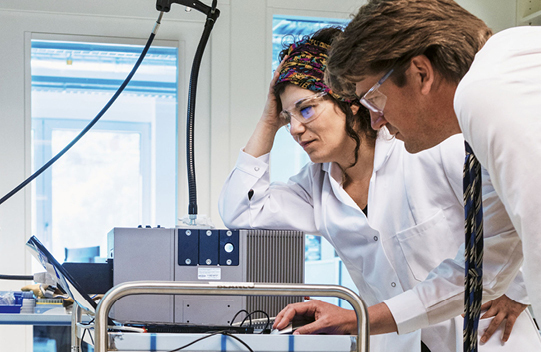50 Years of Research
Article published in EPFL Magazine 28
By Anne-Muriel Brouet, Nathalie Jollien, and Laureline Duvillard

What does it mean to be a researcher today at an institution like EPFL? On the occasion of the Research Days, from September 10 to 14, celebrating the School’s 50th anniversary, EPFL Magazine delved into the work of researchers and PhD students.

At EPFL, research is based on freedom and diversity.
Over 6,000 people, 382 scientific papers per month, 132 inventions, and technology declarations in 2018. These are three indicators of the weight of research at EPFL. How else can one grasp the abundance that crosses the institution, from Bachelor students to full professors, from faculties to doctoral programs, including institutes and labs, from life sciences to materials science, not forgetting energy, habitat, or robotics? The variety of themes and structures characterize research at EPFL, reflecting a single commitment to diversity and freedom.
“The professor’s role is protected in the same way that a judge’s role is protected, to safeguard academic freedom,” says Andreas Mortensen, Vice President for Research. “We can only select the fields in which we hire professors, allocate resources, or time.”
At EPFL, the tenure system ensures this academic freedom. A professor keeps their chair until retirement and can only be dismissed for breaking the law, institutional rules, or ethical standards. New professors are either already tenured or put on the tenure track, a practice from the US, where EPFL was a pioneer in Europe. “The tenure track guarantees that a person will only be judged on the quality of their contributions, not whether the institution has the money for the position. The system’s ethics require EPFL to make a financial commitment for the person’s entire career,” assures the Vice President.
The Right to Fail
Another advantage EPFL professors have is a basic endowment. This invaluable fund, especially at the start, “gives the professor the right to fail. With their ordinary credit, they can conduct experiments and launch ideas. If successful, they can write a research proposal. If not, it’s of little consequence,” observes Andreas Mortensen.
Although academic freedom is sacred, certain values guide research direction. “It’s important for us to be recognized and have an impact, especially in Switzerland, as we benefit from taxpayer money,” says Mortensen. “More broadly, we aim for a positive impact on the planet, which is why we focus on the UN’s strategic goals. Essentially, in their work, professors are expected to clean up rather than pollute the planet, consume less rather than burn more, and so on.”
International Rankings and the Michelin Guide
There is no strategic decision to excel in one particular field only. “We aim for excellence in all the fields we are active in,” continues the Vice President. Do rankings indicate success? “The issue with rankings is that people read them – and often take them too seriously. In any case, they are far less precise than Michelin stars are for restaurants. Just consider that in academia, the time constant is extremely long: some universities have reputations built over 500 years. Applying a fluctuating measure, akin to a sports bulletin, to academia isn’t very appropriate.”
How then can we measure the School’s excellence? “When we are competing with the best universities to hire a professor and we are chosen, we know we’re good. The same goes for students: if they’re competing to come here, we know we’re recognized. Sold patents are also important indicators, as are publications, our ability to attract funding, or more recent impact vehicles like the volume of data published online or initiatives followed by citizens, for example.”
How then can we measure the School’s excellence? “When we are competing with the best universities to hire a professor and we are chosen, we know we’re good. The same goes for students: if they’re competing to come here, we know we’re recognized. Sold patents are also important indicators, as are publications, our ability to attract funding, or more recent impact vehicles like the volume of data published online or initiatives followed by citizens, for example.”
The Five Most Impactful EPFL Publications
According to the Citation Normalized Index (CNCI), which compares the number of citations for each publication to the average citation rate in the same research field and publication year.
CNCI/Title/Authors/Publication Year/Journal/Field
- 842, “A low-cost, high-efficiency solar cell based on dye-sensitized colloidal TiO2 films”, Grätzel M., 1991, Nature, Chemistry.
- 284, “Single-layer MoS2 transistors”, Radisavljevic B., Radenovic A., Brivio J., Giacometti V., Kis A., 2011, Nature Nanotechnology, Materials Science.
- 260, “Planck 2013 results. XVI. Cosmological parameters”, Lesgourgues J., 2014, Astronomy & Astrophysics, Space Science.
- 247, “RAxML-VI-HPC: Maximum likelihood-based phylogenetic analyses with thousands of taxa and mixed models”, Stamatakis A., 2006, Bioinformatics, Biology & Biochemistry.
- 181, “SLIC Superpixels Compared to State-of-the-Art Superpixel Methods”, Achanta R., Shaji A., Lucchi A., Fua P., Susstrunk S., 2012, IEEE Transactions on Pattern Analysis and Machine Intelligence, Engineering.
Excluding reviews. Source: InCites, consulted on 20.05.2019